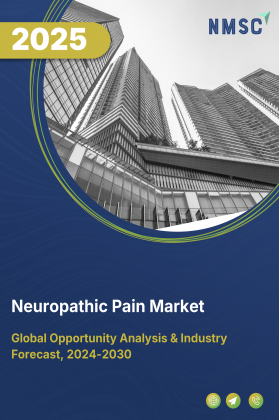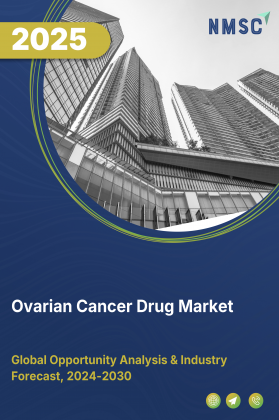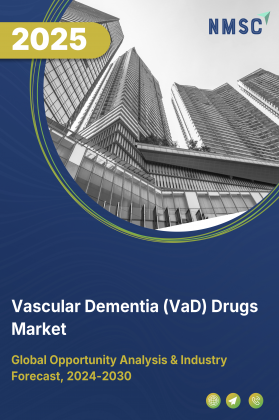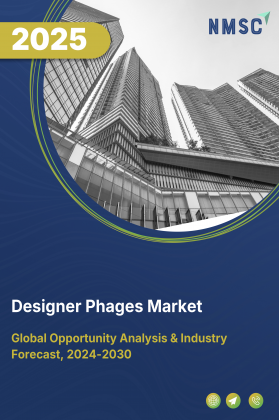
Neuropathic Pain Market by Drug Class (Antidepressants, Anticonvulsants, Opioids, Capsaicin, and Others), by Indication (Diabetic Neuropathy, Chemotherapy-Induced Peripheral Neuropathy, Postherpetic Neuralgia and Others), by Route of Administration (Oral, Topical, Injectable), and by Distribution Channel (Hospital Pharmacies, Drug Stores & Retail Pharmacies, and E-commerce Platforms) – Global Opportunity Analysis and Industry Forecast 2025 – 2030.
Industry Outlook
The global Neuropathic Pain Market size was valued at USD 9.62 billion in 2024, with an estimation of USD 10.60 billion in 2025 and is predicted to reach USD 17.22 billion by 2030 with a CAGR of 10.2% from 2025-2030. The sector is poised for strong growth, driven by the increasing prevalence of chronic diseases, an aging population, and rising healthcare investments.
As conditions like diabetes, cancer, and neurodegenerative disorders become more common, the incidence of nerve damage and associated pain continues to rise, creating a growing demand for effective treatments and therapies. The expanding elderly population, who are more susceptible to conditions that cause neuropathic pain, further supports the need for advanced pain management solutions.
Additionally, increased healthcare expenditure is facilitating research, innovation, and broader access to specialized therapies, enabling better diagnosis and management of neuropathic pain. Together, these factors indicate a promising outlook for the market, with opportunities for continued innovation and improved patient care worldwide.
Rising Chronic Disease Burden Fuels Market Growth
The growing prevalence of chronic conditions such as diabetes and cancer significantly contributes to nerve damage, leading to a surge in neuropathic pain cases worldwide. As these diseases continue to rise, the demand for effective treatments, medications, and therapies to manage pain is increasing, propelling the market forward.
According to the latest International Diabetes Atlas report, the number of people living with diabetes was 5.36 million in 2021 and is expected to reach 7.83 million by 2045, an alarming 46.1% increase over 24 years. With this sharp rise in chronic disease incidence and the resulting growth in neuropathic pain cases, the market for pain management solutions is set to witness significant expansion, emphasizing the urgent need for continued research, innovation, and accessibility in neuropathic pain therapies worldwide.
Expanding Elderly Population Boosts Market Growth
The increasing number of elderly individuals is a key driver of the neuropathic pain market demand, as older adults are more prone to conditions like arthritis and neurodegenerative diseases that result in neuropathic pain. This growing prevalence underscores the rising demand for effective pain management therapies.
According to the World Population Prospects 2022, the global population aged 65 and above accounted for 10% in 2022 and is projected to reach 16% by 2050, highlighting a significant opportunity for the neuropathic pain market growth.
Rising Healthcare Expenditure Accelerates the Market Growth
Increasing global healthcare expenditure is significantly advancing the development of innovative therapies, enhancing access to specialized treatments, and improving healthcare infrastructure for diagnosing and managing neuropathic pain. This growing financial support drives market expansion by fostering research in neuropathic pain management.
According to the World Bank, global healthcare expenditure as a percentage of GDP rose from 9.36% in 2011 to 10.35% in 2021. Additionally, the Centers for Medicare & Medicaid Services estimated that national health spending in the U.S. grew by 8.2% in 2024 and is expected to increase by 7.1% in 2025, reflecting continued investment in healthcare systems that support advanced pain management solutions.
High Treatment Costs and Limited Accessibility in the Neuropathic Pain Market
Advanced therapies and innovative medications for neuropathic pain come with high costs, making them unaffordable for a significant portion of patients. This financial constraint limits treatment adoption and poses a major challenge to the growth of the market, especially in developing regions where healthcare affordability remains a concern.
Additionally, the lack of reimbursement coverage in many countries further exacerbates the issue, preventing patients from accessing cutting-edge therapies. The combination of high out-of-pocket expenses, limited insurance support, and economic disparities continues to hinder widespread market penetration and delays the adoption of new pain management solutions.
Adoption of Advanced Therapies Present Significant Future Opportunity for the Market
The adoption of advanced technologies presents a significant growth opportunity for the neuropathic pain market expansion. Emerging therapies such as neuromodulation, non-ablative implantable devices, and targeted drug delivery systems offer precise and effective pain relief with minimal side effects.
These innovations not only improve patient outcomes but also reduce reliance on opioid-based treatments, addressing safety and compliance concerns. As research continues and technology becomes more accessible, the demand for these advanced solutions is expected to rise, driving substantial market expansion in the coming years.
Market Segmentations and Scope of the Study
The neuropathic pain market report is segmented on the basis of drug class, indication, route of administration, and distribution channel. On the basis of drug class, the market is segmented into antidepressants, anticonvulsants, opioids, capsaicin, and others. On the basis of indication, the market is divided into diabetic neuropathy, chemotherapy-induced peripheral neuropathy, postherpetic neuralgia, trigeminal neuralgia, spinal stenosis–related neuropathy, and others. On the basis of route of administration, the market is classified into oral, topical, and injectable. On the basis of distribution channel, the market is segmented into hospitals, pharmacies, drug stores & retail pharmacies, and e-commerce platforms. The regional breakdown includes regions such as North America, Europe, Asia-Pacific, and the Rest of the World (RoW).
Geographical Analysis
North America dominates the global neuropathic pain market share and is expected to maintain its leadership throughout the forecast period. This is attributed to high healthcare expenditure, well-established healthcare infrastructure, and the widespread availability of advanced therapies for diagnosing and managing neuropathic pain. Strong investment in research and development, favorable reimbursement policies, and growing patient awareness further support industry growth in the region.
Europe represents a significant market for neuropathic pain due to well-established healthcare systems, a growing aging population, and strong regulatory support for advanced pain management therapies. The adoption of non-opioid treatments and innovative solutions is driving market demand across major European countries. Additionally, the aging demographic is expected to further boost market growth, with projections indicating that the share of individuals aged 80 and above in the EU will increase from 6.1% in 2024 to 15.3% by 2100, highlighting a rising need for effective neuropathic pain management solutions.
Asia-Pacific is emerging as the fastest-growing region in the neuropathic pain industry. The rise in the elderly population, who are more prone to chronic conditions such as arthritis and neurodegenerative diseases, is driving an increase in neuropathic pain cases. Healthcare systems in the region are increasingly focusing on specialized treatments, boosting the demand for effective pain management solutions.
Additionally, the increasing prevalence of diabetes further propels the market growth, as a rise in diabetes cases leads to a greater incidence of nerve damage and related pain, prompting the need for specialized and targeted therapies. According to the latest report of the International Diabetes Federation, the number of diabetes patients in India was 74,000 in 2021 and is projected to reach 124,000 by 2045, representing a 67.6% increase over 24 years. Rising healthcare investments, awareness, and adoption of advanced therapies are expected to drive significant market expansion in the region.
The Rest of the World (RoW) region, including Latin America, the Middle East, and Africa, is gradually emerging as a potential growth area. Although the market currently faces challenges related to healthcare accessibility and spending, increasing awareness of neuropathic pain, growing incidence of chronic diseases, and improvements in healthcare infrastructure are expected to create new growth opportunities in these regions over the forecast period.
Strategic Innovations Adopted by Key Players
The global neuropathic pain industry is being shaped by a mix of innovation, accessibility, and partnerships across leading players. Pfizer, GSK, Biogen, and Eli Lilly leverage strong R&D to expand therapeutic options, while Teva enhances affordability and access through its generics and specialty medicines. Vertex and Grünenthal drive innovation with non-opioid and novel mechanism therapies, and Helixmith explores advanced modalities like gene therapy.
Companies such as Astellas, Johnson & Johnson, and Novartis strengthen the market through collaborations and emerging pathways, whereas Endo focuses on safer opioid formulations. MD Biosciences and Lexicon support growth by accelerating research and targeting niche areas. Together, these strategies expand treatment choices, improve accessibility, and stimulate long-term market growth.
Key Benefits
-
The report provides quantitative analysis and estimations of the industry from 2025 to 2030, which assists in identifying the prevailing market opportunities.
-
The study comprises a deep-dive analysis of the including the current and future neuropathic pain market trends to depict prevalent investment pockets in the sector.
-
Information related to key drivers, restraints, and opportunities and their impact on the market is provided in the report.
-
Competitive analysis of the players, along with their market share is provided in the report.
-
SWOT analysis and Porters Five Forces model is elaborated in the study.
-
Value chain analysis in the market study provides a clear picture of roles of stakeholders
Neuropathic Pain Market Key Segments
By Drug Class
-
Antidepressants
-
Tricyclic Antidepressants
-
Serotonin–Noradrenaline Reuptake Inhibitors
-
-
Anticonvulsant
-
Opioids
-
Capsaicin
-
Others
By Indication
-
Diabetic Neuropathy
-
Chemotherapy-Induced Peripheral Neuropathy
-
Postherpetic Neuralgia
-
Trigeminal Neuralgia
-
Spinal Stenosis–Related Neuropathy
-
Others
By Route of Administration
-
Oral
-
Topical
-
Injectable
By Distribution Channel
-
Hospital Pharmacies
-
Drug Stores & Retail Pharmacies
-
E-commerce Platforms
By Region
-
North America
-
The U.S.
-
Canada
-
Mexico
-
-
Europe
-
The UK
-
Germany
-
France
-
Italy
-
Spain
-
Denmark
-
Netherlands
-
Finland
-
Sweden
-
Norway
-
Russia
-
Rest of Europe
-
-
Asia-Pacific
-
China
-
Japan
-
India
-
South Korea
-
Australia
-
Indonesia
-
Singapore
-
Taiwan
-
Thailand
-
Rest of Asia-Pacific
-
-
RoW
-
Latin America
-
Middle East
-
Africa
-
Key Players
-
Pfizer Inc
-
MD Biosciences, Inc
-
GlaxoSmithKline plc
-
Biogen Inc
-
Teva Pharmaceutical Industries Ltd
-
Lexicon Pharmaceuticals, Inc
-
Astellas Pharma Inc
-
Eli Lilly and Company
-
GSK
-
Johnson & Johnson Services, Inc
-
Novartis AG
-
Endo Pharmaceuticals Inc
-
Helixmith Co., Ltd
-
Grunenthal GmbH
Report Scope and Segmentation
|
Parameters |
Details |
|
Market Size in 2025 |
USD 10.60 Billion |
|
Revenue Forecast in 2030 |
USD 17.22 Billion |
|
Growth Rate |
CAGR of 10.2% from 2025 to 2030 |
|
Analysis Period |
2024–2030 |
|
Base Year Considered |
2024 |
|
Forecast Period |
2025–2030 |
|
Market Size Estimation |
Billion (USD) |
|
Growth Factors |
|
|
Countries Covered |
28 |
|
Companies Profiled |
10 |
|
Market Share |
Available for 10 companies |
|
Customization Scope |
Free customization (equivalent up to 80 working hours of analysts) after purchase. Addition or alteration to country, regional, and segment scope. |
|
Pricing and Purchase Options |
Avail customized purchase options to meet your exact research needs. |

















 Speak to Our Analyst
Speak to Our Analyst

























